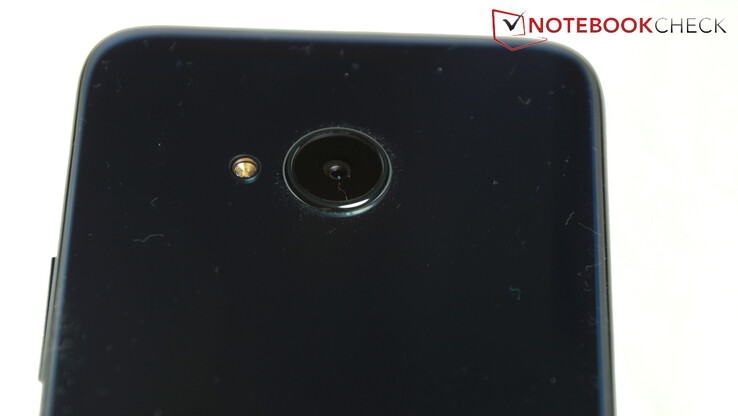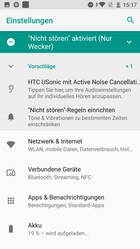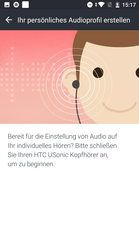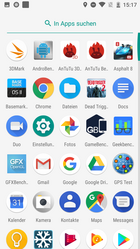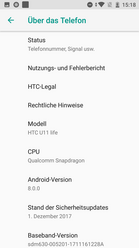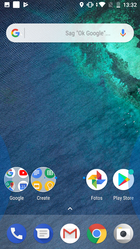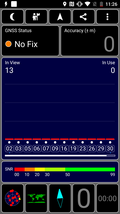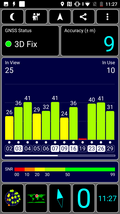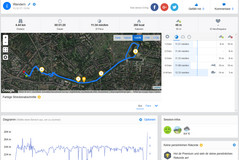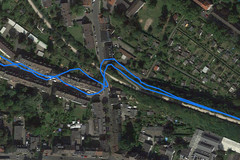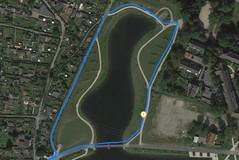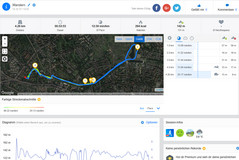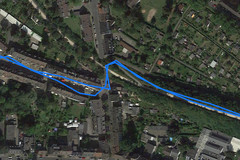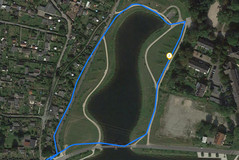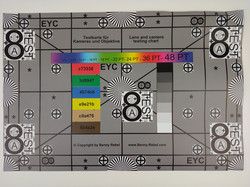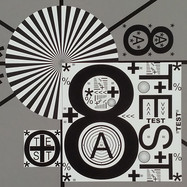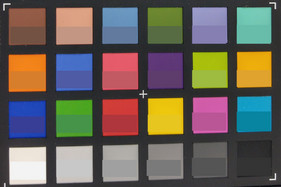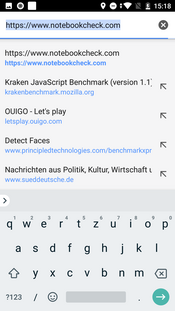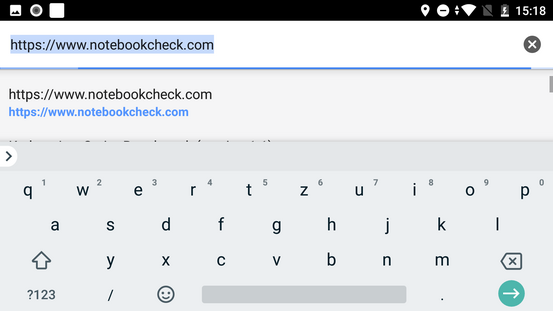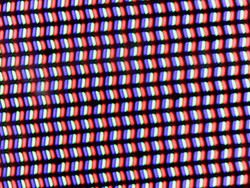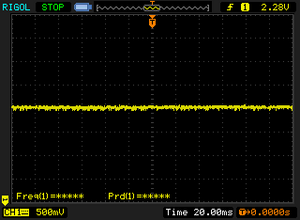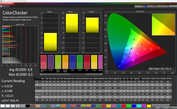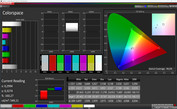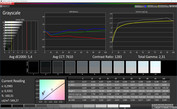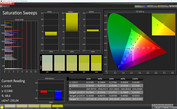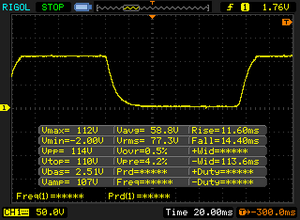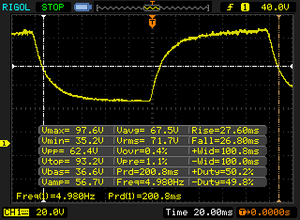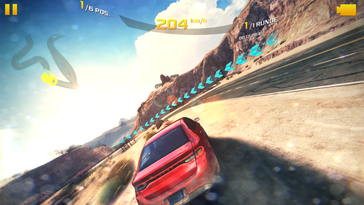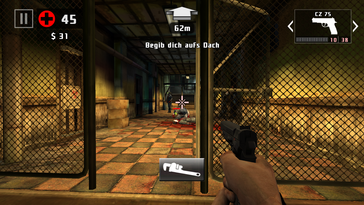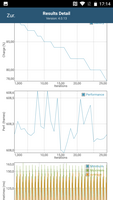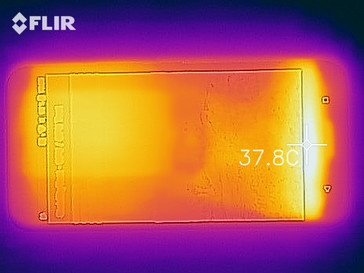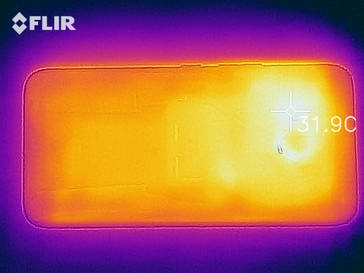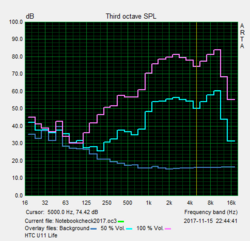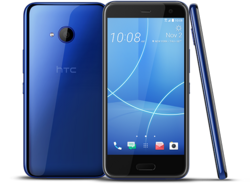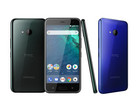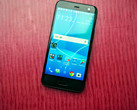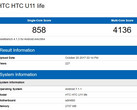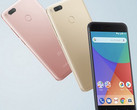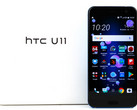HTC U11 Life Smartphone Review
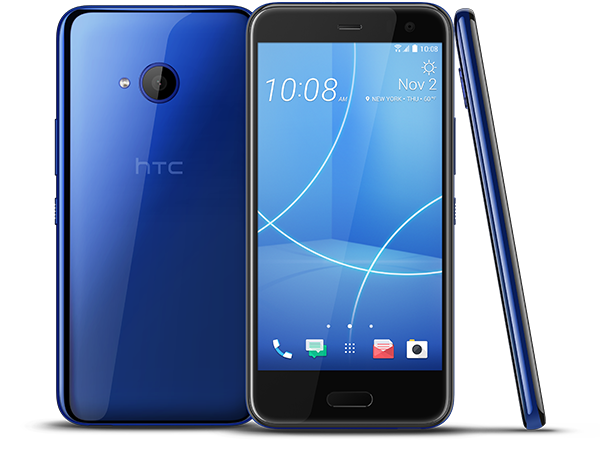
The Taiwanese manufacturer HTC likes to think up something new to convince smartphone buyers. With large pixels in the camera for more light sensitivity, very powerful speakers which point towards the front, or optical image stabilizers in both cameras, there have been some convincing arguments before. One of the newest innovations at HTC is Edge Sense, which incorporates the edges of the smartphone into the operation to facilitate taking pictures or starting apps, for example. We already liked how the HTC U11 has implemented this technology, but there were some problems in the first version. Now this has also come into the mid-range with the HTC U11 Life.
The U11 Life, which is equipped with a 5.2-inch display and officially costs 349 Euros (~$426; $349 unlocked in the US), also brings some other features from HTC's high-end smartphone. For example, it is protected against water and dust according to IP67 and includes U-Sonic earphones, which adjust the sound to the user via ultra-sound measurement and also offers active noise cancellation.
This sounds like an interesting overall package. This price range also includes the Honor 9 or Samsungs Galaxy A5, for example, and we also include the BQ Aquaris X Pro and the Xiaomi Mi 5s in our comparison.
Case
HTC has also used the design of the U11, which is called "Liquid Design" and impresses with flowing lines and multiple layers on the back resulting in color reflections. However, in the HTC U11 Life the back is not made of glass but acrylic resin which gives slightly less of a high-quality impression. The smartphone is also very susceptible to dust and fingerprints. While the color reflections created by the multiple layers are still pleasing to look at, they are not as pronounced in the black model. In central Europe, currently you also have an option to purchase a blue HTC U11 Life. The display bezels are still quite large, and HTC did not adopt the more modern design with much reduced bezels from other current smartphones.
The case itself is very robust, and you cannot see any effects in the liquid crystal from pressing on the screen or the back. However, strong pressure on the back can possibly trigger Edge Sense (depending on the sensitivity adjustment) which caused it to suddenly take inadvertent pictures with the camera in our test. The HTC U11 Life is a quite light, 5.2-inch smartphone, which fits in the hand nicely due to its rounded corners. We did not like the transition of materials between the frame and the back as much, since it was clearly noticeable and felt quite rough.
The case is protected from dust and water according to IP67. The impression of its quality is good overall, but the Honor 9 or Samsung Galaxy A5 offer a slightly higher-quality impression.
Features
The model we tested offers 3 GB of RAM and 32 GB of storage. You can also get a model with 4 GB/64 GB from HTC directly, and it costs 379 Euros (~$462). What stands out and is unusual for a mid-range smartphone is that there is no 3.5-mm audio port, and the headphones have to be connected via the USB-C port. HTC explains this with the USonic sound adjustment and the active noise-suppression, which can only be done in this way. An adapter to 3.5 mm is not included with the smartphone. The USB-C port only supports USB-2.0 speed, but can also be used for USB-OTG.
The HTC U11 Life is only available as a single-SIM smartphone, and you can also insert an additional microSD card into the SIM tray, which supports up to 2 TB of storage. The storage card cannot be formatted as internal storage, and you cannot move any apps onto external storage. NFC and Bluetooth 5.0 are also on board.
Software
The HTC U11 Life is one of the first smartphones that has reached the German market with Google's Android One. This initiative was actually developed by Google in order to enssure a current operating system for more affordable smartphones in developing countries and emerging markets and prevent the fragmentation of Android. While the manufacturer commits to refrain from any larger adaptations of the software, Google is obliged to provide security updates for three years and update the operating system for two years.
This results in the HTC U11 Life having the current operating system, something that is quite rare particularly in devices below the high-end range. Android 8 is already preinstalled, and at the time of our test, the security patches are from December 1, 2017, which makes them just one month old. Since in the past, manufacturers have needed a lot of time or did not even deliver any updates, fans of a current operating system should be very pleased with this. As a small caveat, we should say that Android 8.1 which is the absolutely newest Android version is not yet installed, but this has only been available since the beginning of December.
HTC also has stayed within the guidelines and only includes the apps on the HTC U11 Life that are customarily included in Android. There are only minimal adjustments in the settings for Edge Sense and USonic. Anyone who likes a slim operating system should be pleased. By the way, HTC emphasizes that not all its mid-range smartphones will be delivered with Android One in the future, and HTC Sense, its own variant of Android, will continue to be used.
Communication and GPS
In addition to the slower 802.11 a/b/g/n standards, the fast 802.11-ac WLAN is also supported. In particular when sending, the U11 Life is able to make use of the speed well, while its speeds when receiving data via WLAN are only in the middle of the field. Near the router, the connection is available with full signal strength and pages are rendered at medium speeds. At 10 meters distance from the router and through three walls, the pages are rendered at a similar speed, but the signal strength is at 50%.
The HTC U11 Life supports 15 LTE bands and is thus extensively equipped for its price range. You should be able to find an LTE net in most countries abroad with this. The smartphone is also able to send and receive data via LTE at fast speeds. A maximum of 600 MBit/s are available when downloading, and 75 MBit/s during upload. Other smartphones of this price range have a hard time to keep up with this. The signal strength is also good. Even indoors, we almost always had at least half the LTE signal strength in the center of town in the well-developed German D2 net.
| Networking | |
| iperf3 transmit AX12 | |
| HTC U11 Life | |
| Xiaomi Mi 5s | |
| Samsung Galaxy A5 2017 | |
| BQ Aquaris X Pro | |
| Honor 9 | |
| iperf3 receive AX12 | |
| Xiaomi Mi 5s | |
| Honor 9 | |
| BQ Aquaris X Pro | |
| HTC U11 Life | |
| Samsung Galaxy A5 2017 | |
When testing the locating speeds with the GPS-Test app, unfortunately the HTC U11 Life does not do as well. We were unable to determine our location indoors, and outside it took a very, very long time to achieve a usable location accuracy of 9 meters. On Google Maps, we are located fairly accurately.
We are taking a trip with the bike, taking the HTC U11 Life as well as the Garmin Edge 500, a professional navigation device for bike racers, with us. On the mostly straight path, which has trees that can interfere with the reception though, both are becoming a bit confused and are unable to position us accurately on the path. However, during the loop the Garmin Edge 500 accomplishes a much more exact positioning. Thus if you do not need it too often, you can use the HTC U11 Life for navigation, but there are alternatives that are much more accurate and faster.
Telephone Functions and Call Quality
The Telephone app also comes from stock Android and was implemented without any changes. It is quite easy to use, but can also be slightly cumbersome if you use the key pad a lot.
The call quality is acceptable. Even though the internal ear piece can become quite loud, it can then also become boomy, and the voice of your conversation partner sounds slightly tinny at all volume levels. The microphone is very sensitive and can even still record our voice when we are speaking very quietly. On the other hand, loud voices are transferred very boomy. The speaker, which was once a showcase of HTC smartphones, sounds tinny if you use the speaker phone. The microphone then records our voice as if coming from a far distance, giving our conversation partner the impression of a lack of presence.
Cameras
With 16 Megapixels in the front and back, the camera modules are at the same level as the top of the class, the Samsung Galaxy A5. However, even 12 Megapixels and 8 Megapixels in front are not a rarity in this price range, so that the HTC U11 Life can score here in terms of its numbers.
The main camera of our test unit lights up standard situations well, but details such as the pine needles on the ground in the second image quickly become muddy and lose sharpness. In general, we like the brightness, while the image sharpness could be slightly higher. The main camera also masters low-light situations quite well, but we also complain about the lack of sharpness in the detail.
Videos can be recorded at a maximum of 2160p and 30 fps resulting in good and colorful videos in good light conditions, and the exposure sensor adjusts quickly to the surroundings. However, some problems lacking sharpness become visible in the detail, and there is significant color noise in darker areas.
The front camera lights up dark areas rather moderately, and with the fixed focus, you have to chose the distance to your object well in order to get a sharp image. In general, the camera lacks sharpness in the detail, and you can also see significant color noise. While the front camera is surely sufficient for the occasional selfie, anyone who values a good self portrait will probably be better served by another smartphone.
The main camera also has to prove itself in our test lab, where we use it to take pictures under controlled light conditions. While its reproduction of the test chart is quite sharp, there are clear artifacts at the edges. Text in front of red background appears quite blurry, and the sharpness diminishes slightly towards the edges. Color areas are often reproduced with artifacts or slightly too pale.
Accessories and Warranty
HTC includes USonic earphones with active noise cancellation and ultrasound sound adjustment to the ear shape of the user. There is also a quite slim Quick-Charge device in the box, as well as a USB-C cable and a SIM tool.
The in-ear headset offers a full, dynamic sound, and in particular with mid-range smartphones you hardly find such good earphones included in the box. However, the earphones only have a USB-C connector, so you can only use them with devices that offer such a connection.
You can get additional accessories in the HTC accessories shop. The charger costs 35 Euros (~$43), and you can get a car charger for the same price. You can also find a clear silicone case with Edge-Sense adjustment, however we cannot find the price. The USonic earphones are available for 40 Euros (~$49), and an adapter to a 3.5-mm audio port costs 13 Euros (~$16).
The warranty is 24 months. Please see our Guarantees, Return Policies and Warranties FAQ for country-specific information.
Input Devices and Operation
The virtual keyboard will also look familiar to Android veterans, since it is Google's GBoard. Anyone who would prefer a different keyboard can download this from the Google Play Store, but they should be careful to chose a reputable vendor. It is easy to type using GBoard, and you can adjust many settings.
The touchscreen is also very sensitive in the corners and edges, it is easy to operate, and the fingers slide easily. Underneath the display are illuminated keys for the overview of the open apps and the back function. The fingerprint sensor serves as the Home button. The system can be operated easily with these keys. Except for the Google standards, gestures or navigation extensions are not integrated.
The fingerprint sensor responds quite fast and reliably to a finger placement. It also works in Standby mode and after a brief delay displays the Start screen for the user.
HTS praises Edge Sense, which is the additional operation using the device edges, as a highlight. You can short-press or press-and-hold and define actions for each of these operations. For example, you can start the camera, accept a call, or respond to the alarm clock. You can also for example activate the camera from Standby. We had to experiment a little until we found the right pressure strength and would have liked perhaps a few more pressure levels, since as it is, you either have to press very hard on the edges or you inadvertently activate the functions a lot. However, after some getting used to, it is a very interesting extension to the smartphone operation, and this function is particularly well suited to take pictures.
Display
The HTC U11 Life offers a 5.2-inch display with a Full HD resolution. This is the usual equipment in this price range, and our test unit has an SLCD display. Only Samsung uses an AMOLED display for its Galaxy A5, and all the other manufacturers in our comparison are using the IPS technology.
At 526 cd/m² on average, the display brightness is quite high. However, at only 87%, the display distribution is not quite as even as in many other smartphones, and the display is darker mainly in the top third and there in particular in the center. But even in larger color areas, you can hardly see this with your bare eyes.
| |||||||||||||||||||||||||
Brightness Distribution: 87 %
Center on Battery: 545 cd/m²
Contrast: 1298:1 (Black: 0.42 cd/m²)
ΔE ColorChecker Calman: 4.9 | ∀{0.5-29.43 Ø4.78}
ΔE Greyscale Calman: 5.4 | ∀{0.09-98 Ø5}
Gamma: 2.31
CCT: 7610 K
| HTC U11 Life SLCD, 1920x1080, 5.2" | Honor 9 IPS/LTPS, 1920x1080, 5.2" | BQ Aquaris X Pro IPS, 1920x1080, 5.2" | Xiaomi Mi 5s IPS, 1920x1080, 5.2" | Samsung Galaxy A5 2017 Super AMOLED, 1920x1080, 5.2" | |
|---|---|---|---|---|---|
| Screen | 15% | -36% | 1% | 36% | |
| Brightness middle (cd/m²) | 545 | 550 1% | 458 -16% | 627 15% | 539 -1% |
| Brightness (cd/m²) | 526 | 535 2% | 473 -10% | 596 13% | 542 3% |
| Brightness Distribution (%) | 87 | 92 6% | 88 1% | 91 5% | 93 7% |
| Black Level * (cd/m²) | 0.42 | 0.42 -0% | 0.51 -21% | 0.6 -43% | |
| Contrast (:1) | 1298 | 1310 1% | 898 -31% | 1045 -19% | |
| Colorchecker dE 2000 * | 4.9 | 3.3 33% | 7.1 -45% | 4.5 8% | 1.6 67% |
| Colorchecker dE 2000 max. * | 8.5 | 4.5 47% | 14.5 -71% | 7.5 12% | 2.6 69% |
| Greyscale dE 2000 * | 5.4 | 3.6 33% | 10.5 -94% | 4.5 17% | 1.5 72% |
| Gamma | 2.31 95% | 2.38 92% | 2.28 96% | 2.26 97% | 2.28 96% |
| CCT | 7610 85% | 7226 90% | 8951 73% | 7427 88% | 6422 101% |
* ... smaller is better
Screen Flickering / PWM (Pulse-Width Modulation)
| Screen flickering / PWM not detected | |||
In comparison: 53 % of all tested devices do not use PWM to dim the display. If PWM was detected, an average of 8101 (minimum: 5 - maximum: 343500) Hz was measured. | |||
The black value of 0.42 cd/m² is decent and even good in the direct comparison to the other competitors. Only the Samsung Galaxy A5 with the AMOLED display naturally cannot be beaten by anyone. At 1298:1, the contrast is also quite high. Colors subjectively appear quite saturated. However, dark areas are still visibly illuminated and therefore appear more as a dark gray.
A significant blue tint becomes visible in the test with the CalMAN software and the spectral photometer. This can only be corrected by the system wide night mode which adds a larger amount of yellow to the image. While the color space coverage for sRGB is fairly high, the color accuracy is rather mediocre, and here again the Samsung Galaxy A5 can hardly be beaten.
Display Response Times
| ↔ Response Time Black to White | ||
|---|---|---|
| 26 ms ... rise ↗ and fall ↘ combined | ↗ 11.6 ms rise | |
| ↘ 14.4 ms fall | ||
| The screen shows relatively slow response rates in our tests and may be too slow for gamers. In comparison, all tested devices range from 0.1 (minimum) to 240 (maximum) ms. » 61 % of all devices are better. This means that the measured response time is worse than the average of all tested devices (20.2 ms). | ||
| ↔ Response Time 50% Grey to 80% Grey | ||
| 54.4 ms ... rise ↗ and fall ↘ combined | ↗ 27.6 ms rise | |
| ↘ 26.8 ms fall | ||
| The screen shows slow response rates in our tests and will be unsatisfactory for gamers. In comparison, all tested devices range from 0.165 (minimum) to 636 (maximum) ms. » 91 % of all devices are better. This means that the measured response time is worse than the average of all tested devices (31.6 ms). | ||
Due to the lack of a gap between the glass and the display, the SLCD technology is supposed to ensure that less reflections interfere when looking at the screen. In our test, you can definitely use the HTC U11 Life outdoors, but with a reflective display surface you cannot completely avoid reflections, and they are also annoying here. In addition, the brightness sensor does not always react to the surrounding light correctly and sometimes adjusts the display too dark.
The viewing angles are good, and you can also recognize the image from very steep angles. However, there are some clearly visible brightness changes.
Performance
The Qualcomm Snapdragon 630 is a modern mid-range SoC which can definitely move quite fast. It is interesting that the processor section of the BQ Aquaris X Pro with the Snapdragon 626 clearly loses in some areas, while the modern graphics chip, an Adreno 508, offers significantly more power than that in the BQ smartphone.
Overall, the performance is of course significantly lower than that of the Honor 9 or the Xiaomi Mi 5s, which both offer high-end SoCs. You can notice this in a menu navigation that is generally slightly slower. However, this really only becomes noticeable if you operate high-end and mid-range devices directly one after another. Looking at it by itself, the HTC U11 Life also can be navigated quickly. It is also noticeably faster in the benchmarks than the Samsung Galaxy A5. Overall, this is a promising start of the Performance section.
| AnTuTu v6 - Total Score (sort by value) | |
| HTC U11 Life | |
| Honor 9 | |
| BQ Aquaris X Pro | |
| Xiaomi Mi 5s | |
| Samsung Galaxy A5 2017 | |
| Asus ZenFone 4 ZE554KL | |
| PCMark for Android | |
| Work performance score (sort by value) | |
| HTC U11 Life | |
| Honor 9 | |
| BQ Aquaris X Pro | |
| Xiaomi Mi 5s | |
| Samsung Galaxy A5 2017 | |
| Asus ZenFone 4 ZE554KL | |
| Work 2.0 performance score (sort by value) | |
| HTC U11 Life | |
| Honor 9 | |
| BQ Aquaris X Pro | |
| Samsung Galaxy A5 2017 | |
| Asus ZenFone 4 ZE554KL | |
| Geekbench 4.4 | |
| 64 Bit Single-Core Score (sort by value) | |
| HTC U11 Life | |
| Honor 9 | |
| BQ Aquaris X Pro | |
| Samsung Galaxy A5 2017 | |
| Asus ZenFone 4 ZE554KL | |
| 64 Bit Multi-Core Score (sort by value) | |
| HTC U11 Life | |
| Honor 9 | |
| BQ Aquaris X Pro | |
| Samsung Galaxy A5 2017 | |
| Asus ZenFone 4 ZE554KL | |
| Compute RenderScript Score (sort by value) | |
| HTC U11 Life | |
| Honor 9 | |
| Samsung Galaxy A5 2017 | |
| Asus ZenFone 4 ZE554KL | |
| GFXBench (DX / GLBenchmark) 2.7 | |
| T-Rex Onscreen (sort by value) | |
| HTC U11 Life | |
| Honor 9 | |
| BQ Aquaris X Pro | |
| Xiaomi Mi 5s | |
| Samsung Galaxy A5 2017 | |
| Asus ZenFone 4 ZE554KL | |
| 1920x1080 T-Rex Offscreen (sort by value) | |
| HTC U11 Life | |
| Honor 9 | |
| BQ Aquaris X Pro | |
| Xiaomi Mi 5s | |
| Samsung Galaxy A5 2017 | |
| Asus ZenFone 4 ZE554KL | |
| GFXBench 3.0 | |
| on screen Manhattan Onscreen OGL (sort by value) | |
| HTC U11 Life | |
| Honor 9 | |
| BQ Aquaris X Pro | |
| Xiaomi Mi 5s | |
| Samsung Galaxy A5 2017 | |
| Asus ZenFone 4 ZE554KL | |
| 1920x1080 1080p Manhattan Offscreen (sort by value) | |
| HTC U11 Life | |
| Honor 9 | |
| BQ Aquaris X Pro | |
| Xiaomi Mi 5s | |
| Samsung Galaxy A5 2017 | |
| Asus ZenFone 4 ZE554KL | |
| GFXBench 3.1 | |
| on screen Manhattan ES 3.1 Onscreen (sort by value) | |
| HTC U11 Life | |
| Honor 9 | |
| BQ Aquaris X Pro | |
| Xiaomi Mi 5s | |
| Samsung Galaxy A5 2017 | |
| Asus ZenFone 4 ZE554KL | |
| 1920x1080 Manhattan ES 3.1 Offscreen (sort by value) | |
| HTC U11 Life | |
| Honor 9 | |
| BQ Aquaris X Pro | |
| Xiaomi Mi 5s | |
| Samsung Galaxy A5 2017 | |
| Asus ZenFone 4 ZE554KL | |
| GFXBench | |
| on screen Car Chase Onscreen (sort by value) | |
| HTC U11 Life | |
| Honor 9 | |
| BQ Aquaris X Pro | |
| Xiaomi Mi 5s | |
| Samsung Galaxy A5 2017 | |
| Asus ZenFone 4 ZE554KL | |
| 1920x1080 Car Chase Offscreen (sort by value) | |
| HTC U11 Life | |
| Honor 9 | |
| BQ Aquaris X Pro | |
| Xiaomi Mi 5s | |
| Samsung Galaxy A5 2017 | |
| Asus ZenFone 4 ZE554KL | |
| Lightmark - 1920x1080 1080p (sort by value) | |
| Asus ZenFone 4 ZE554KL | |
| Basemark ES 3.1 / Metal - offscreen Overall Score (sort by value) | |
| Samsung Galaxy A5 2017 | |
| Asus ZenFone 4 ZE554KL | |
While the HTC U11 Life is able to keep up with other smartphones of its price-range in terms of browser performance, you can see for example in the Samsung Galaxy A5 that more optimizations are still possible. While you are surfing at an appropriate speed with the HTC U11 Life, at times you have to wait a few seconds until the images have finished loading. However, Google's Interland browser game is loading quickly and then also runs smoothly.
| JetStream 1.1 - Total Score | |
| Honor 9 (Chrome 59) | |
| Xiaomi Mi 5s (Chrome 55) | |
| Samsung Galaxy A5 2017 (Samsung Browser (Chrome 44)) | |
| HTC U11 Life (Chrome 63) | |
| Asus ZenFone 4 ZE554KL (Chrome 62) | |
| BQ Aquaris X Pro (Chrome 59.0.3071.125) | |
| Octane V2 - Total Score | |
| Honor 9 (Chrome 59) | |
| Xiaomi Mi 5s (Chrome 55) | |
| Samsung Galaxy A5 2017 (Samsung Browser (Chrome 44)) | |
| HTC U11 Life (Chrome 63) | |
| BQ Aquaris X Pro (Chrome 59.0.3071.125) | |
| Asus ZenFone 4 ZE554KL (Chrome 62) | |
| Mozilla Kraken 1.1 - Total | |
| HTC U11 Life (Chrome 63) | |
| Asus ZenFone 4 ZE554KL (Chrome 62) | |
| BQ Aquaris X Pro (Chrome 59.0.3071.125) | |
| Samsung Galaxy A5 2017 (Samsung Browser (Chrome 44)) | |
| Honor 9 (Chrome 59) | |
| Xiaomi Mi 5s (Chrome 55) | |
| WebXPRT 2015 - Overall | |
| Honor 9 (Chrome 59) | |
| HTC U11 Life (Chrome 63) | |
| Asus ZenFone 4 ZE554KL (Chrome 62) | |
| Samsung Galaxy A5 2017 (Samsung Browser (Chrome 44)) | |
| BQ Aquaris X Pro (Chrome 59.0.3071.125) | |
* ... smaller is better
Access to our reference storage card, a Toshiba Exceria Pro M501 really occurs quite fast. The access to the internal storage is as fast as in the comparable models, the Galaxy A5 has a large weak spot here.
Since there are no additional apps installed on the HTC U11 Life, there are 22 GB available to the user in the internal data storage.
| HTC U11 Life | Honor 9 | BQ Aquaris X Pro | Xiaomi Mi 5s | Samsung Galaxy A5 2017 | Asus ZenFone 4 ZE554KL | |
|---|---|---|---|---|---|---|
| AndroBench 3-5 | 4% | -14% | 42% | -34% | 14% | |
| Sequential Read 256KB (MB/s) | 268 | 293 9% | 270.5 1% | 412.7 54% | 182 -32% | 287.4 7% |
| Sequential Write 256KB (MB/s) | 120 | 204 70% | 139.6 16% | 153.5 28% | 77.1 -36% | 205.3 71% |
| Random Read 4KB (MB/s) | 39.3 | 55.7 42% | 37.97 -3% | 100.3 155% | 22.41 -43% | 68.6 75% |
| Random Write 4KB (MB/s) | 50.2 | 32.7 -35% | 12.07 -76% | 15.08 -70% | 12.13 -76% | 7.59 -85% |
| Sequential Read 256KB SDCard (MB/s) | 82.8 ? | 68 ? -18% | 78.7 ? -5% | 73.7 ? -11% | 86.9 ? 5% | |
| Sequential Write 256KB SDCard (MB/s) | 59.8 ? | 34.64 ? -42% | 49.77 ? -17% | 56 ? -6% | 66.5 ? 11% |
Games
The gaming performance is not quite sufficient for very demanding games such as "Asphalt 8: Airborne," and the HTC U11 Life only achieves 28 fps here. However, at lower detail level the game is no problem, and so likewise is "Dead Trigger 2." Simpler games such as "Angry Birds" also run smoothly.
You can control the games reliably and precisely via touchscreen and position sensor.
| Asphalt 8: Airborne | |||
| Settings | Value | ||
| high | 28 fps | ||
| very low | 30 fps | ||
| Dead Trigger 2 | |||
| Settings | Value | ||
| high | 30 fps | ||
Emissions
Temperature
Under load, the device warms up most at the bottom in front. We are measuring 35.5 °C (56 °F) here, which is only slightly more than we determined at this spot during idle operation though. Overall, such warming should give no reason for concern, and the device can be carried comfortably in your pants pocket even after a longer operation under load.
We are using the GFXBench battery test to determine whether the performance also remains stable after a very long period of load. The benchmark renders the same sequence for thirty times and saves the achieved frame rates. In the HTC U11 Life, the performance remained stable the whole time, so you should not expect any drops in performance.
(+) The maximum temperature on the upper side is 35.5 °C / 96 F, compared to the average of 35.2 °C / 95 F, ranging from 21.9 to 247 °C for the class Smartphone.
(+) The bottom heats up to a maximum of 31.2 °C / 88 F, compared to the average of 34 °C / 93 F
(+) In idle usage, the average temperature for the upper side is 29.8 °C / 86 F, compared to the device average of 32.9 °C / 91 F.
Speakers
We had already noticed in the HTC U11 that the sound quality of the internal speakers has declined compared to the predecessor. In terms of the speakers, the HTC U11 Life cannot make any claims on a predicate such as "good speakers" anymore. This is due to the squeaky highs for one, which make singing at high volume hardly bearable. You can also see in the graphic of the speaker test that the high highs are strongly overemphasized. In addition, there are hardly any low mids. At least the speakers can basically become quite loud, but the sound always remains very tinny.
At this price level we would expect more, in particular since on the other hand, HTC brags about the sound. The HTC U11 Life is certified for Hi-Res audio, and is definitely able to deliver a good sound through the USonic earphones, and the sound output via Bluetooth is also good. However, it is a strange decision to pair this with such a squeaky speaker.
HTC U11 Life audio analysis
(+) | speakers can play relatively loud (90.2 dB)
Bass 100 - 315 Hz
(-) | nearly no bass - on average 27.5% lower than median
(+) | bass is linear (6.7% delta to prev. frequency)
Mids 400 - 2000 Hz
(±) | reduced mids - on average 9% lower than median
(+) | mids are linear (6.9% delta to prev. frequency)
Highs 2 - 16 kHz
(±) | higher highs - on average 9% higher than median
(+) | highs are linear (4.7% delta to prev. frequency)
Overall 100 - 16.000 Hz
(±) | linearity of overall sound is average (25.4% difference to median)
Compared to same class
» 63% of all tested devices in this class were better, 7% similar, 31% worse
» The best had a delta of 11%, average was 35%, worst was 134%
Compared to all devices tested
» 77% of all tested devices were better, 5% similar, 18% worse
» The best had a delta of 4%, average was 24%, worst was 134%
Samsung Galaxy A5 2017 audio analysis
(+) | speakers can play relatively loud (83 dB)
Bass 100 - 315 Hz
(-) | nearly no bass - on average 15.5% lower than median
(±) | linearity of bass is average (9.1% delta to prev. frequency)
Mids 400 - 2000 Hz
(±) | higher mids - on average 9.4% higher than median
(±) | linearity of mids is average (7.6% delta to prev. frequency)
Highs 2 - 16 kHz
(±) | higher highs - on average 5% higher than median
(±) | linearity of highs is average (7.6% delta to prev. frequency)
Overall 100 - 16.000 Hz
(±) | linearity of overall sound is average (23.6% difference to median)
Compared to same class
» 53% of all tested devices in this class were better, 8% similar, 39% worse
» The best had a delta of 11%, average was 35%, worst was 134%
Compared to all devices tested
» 70% of all tested devices were better, 6% similar, 24% worse
» The best had a delta of 4%, average was 24%, worst was 134%
Frequency comparison (Checkboxes selectable!)
Battery Life
Power Consumption
In terms of power consumption, the HTC U11 Life shows itself to be efficient. Even if the average idle consumption is slightly higher than that of the competition, this is made up by the low consumption under load. When turned off or in standby mode, the HTC U11 Life is also not using too much power.
| Off / Standby | |
| Idle | |
| Load |
|
Key:
min: | |
| HTC U11 Life 2600 mAh | Honor 9 3200 mAh | BQ Aquaris X Pro 3100 mAh | Xiaomi Mi 5s 3200 mAh | Samsung Galaxy A5 2017 3000 mAh | |
|---|---|---|---|---|---|
| Power Consumption | -41% | -6% | -18% | 23% | |
| Idle Minimum * (Watt) | 0.63 | 1.13 -79% | 0.67 -6% | 0.4 37% | 0.64 -2% |
| Idle Average * (Watt) | 2.1 | 2.25 -7% | 1.7 19% | 1.7 19% | 1.36 35% |
| Idle Maximum * (Watt) | 2.15 | 2.3 -7% | 1.78 17% | 1.81 16% | 1.4 35% |
| Load Average * (Watt) | 3.34 | 4.89 -46% | 4.42 -32% | 5.84 -75% | 2.53 24% |
| Load Maximum * (Watt) | 4.83 | 7.99 -65% | 6.3 -30% | 9.12 -89% | 3.63 25% |
* ... smaller is better
Battery Life
While the small 2600 mAh battery can barely offer 9.88 Wh of power, this is still sufficient for quite good runtimes, due to its efficient consumption. Thus 12:05 hours in the WLAN test are quite an achievement, and the HTC U11 Life can last for two days without a recharge in our experience. Under load, the smartphone still lasts slightly longer than the BQ Aquaris X Pro, which has the much larger battery. However, the Samsung Galaxy A5 is again the efficiency king, since it offers 30% more battery life than our test unit.
Thanks to Quick Charge, the smartphone is recharged after about 1:30 hours.
| HTC U11 Life 2600 mAh | Honor 9 3200 mAh | BQ Aquaris X Pro 3100 mAh | Xiaomi Mi 5s 3200 mAh | Samsung Galaxy A5 2017 3000 mAh | |
|---|---|---|---|---|---|
| Battery runtime | -23% | -9% | -8% | 32% | |
| Reader / Idle (h) | 30.3 | 23.3 -23% | 30.7 1% | 40.3 33% | |
| H.264 (h) | 13.3 | 9.4 -29% | 10.7 -20% | 16.4 23% | |
| WiFi v1.3 (h) | 12.1 | 8.6 -29% | 12.2 1% | 11.1 -8% | 14.1 17% |
| Load (h) | 5.1 | 4.6 -10% | 4.2 -18% | 7.8 53% |
Pros
Cons
Verdict
There are still a few things about the HTC U11 Life which make the smartphone stand out among the comparison devices. Again and again, we need to point out HTC's inventive spirit and absolute will of innovation, whose actual result are now also introduced into the mid-range with USonic and Edge Sense. Thanks to the Android-One philosophy, you are ensured updates for several years, which provides a good feeling particularly in times of security holes discovered weekly. You also do not necessarily expect the excellent earphones included in the package of a device for 349 Euros (~$426). However, you also do not expect such a tinny sounding speaker in this price range, particularly not from HTC.
In many other areas, the performance of the HTC U11 Life is solid: a good battery life, a decent display, and a fitting performance for a mid-range device. The case is stylish, but rather average in terms of quality, and besides the new options for operation, Edge Sense also creates some new problems, such as inadvertent activation. The camera likewise delivers a good performance, but does not stand out compared to other smartphones.
Guaranteed regular security updates - this is a strong argument for the HTC U11 Life. A great pair of earphones included and a good battery life are further arguments. But there are also downsides with a bad speaker, lack of audio port, and not very accurate navigation.
All in all, the HTC U11 Life is a device which you should try and take into your own hands. As a buyer, you should ask yourself, how much do I like the case, how well can I deal with Edge Sense, and can I live with the mediocre speaker? Is it okay for me that there is no dedicated audio port? Using the smartphone for navigation should also not be too important for you. Despite all these concerns, the HTC U11 Life might still convince you in this hands-on, particularly if regular security updates are important for you.
HTC U11 Life
- 01/11/2018 v6 (old)
Florian Wimmer




